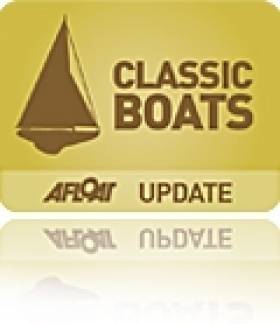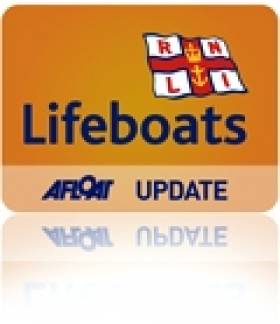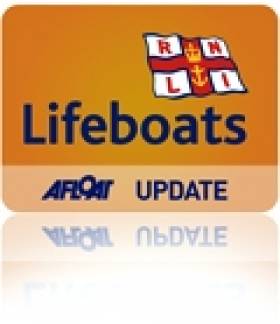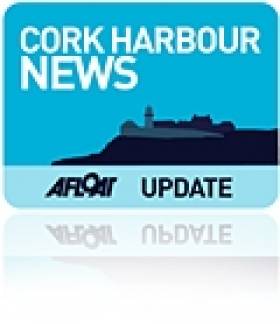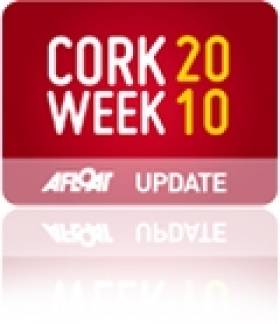Displaying items by tag: Ballycotton Lifeboat
#FamousLifeboat – Former Ballycotton RNLB lifeboat, Mary Stanford, made famous for a daring rescue of the Daunt Rock lightship crew in 1936, was hoisted out from Grand Canal Dock basin yesterday and headed to her old east Cork homeport, writes Jehan Ashmore.
The Barnett-class lifeboat was loaded onto a truck to start the final stage of her homecoming following a campaign to save the vessel from further neglect having languished for many years.
Upon her return to Munster, The Save The Mary Stanford Project committee intend to have the boat raised on a plinth near the entrance to the Ballycotton Cliff walk and they are seeking donations to assist in her restoration that may involve the boat covered during this period.
Her restoration would allow those to appreciate the lifeboat's career and particularly the role she played during Daunt Rock lightship rescue that took place 78 years ago. The 60-hour ordeal would became the first and only lifeboat in RNLI history to have been awarded a gold medal for gallantry, that is for the boat herself, as well as her crew who were recognised for their bravery.
In recent years she was moored alongside Naom Eanna which been given a month's reprieve, otherwise she is to be scrapped by Waterways Ireland.
Famous Ballycotton Lifeboat Saved Leaves Fate of Naom Éanna Open to Dáil Questions?
#FamousLifeboat – Former Ballycotton RNLB lifeboat, Mary Stanford, arguably the most famous vessel to serve the institution, is due to return 'home', following years of neglect in Dublin's Grand Canal Dock, leaving the fate of Naom Éanna much to be desired, writes Jehan Ashmore.
On Wednesday, Naom Éanna, the former Galway-Aran Islands ferry built by Liffey Dockyard in 1958 for the CIE operated service, was moved by Waterways Ireland on foot of safety concerns should the veteran vessel spring a leak and sink in the basin. Such a situation potentially poses health, safety risks not to mention a navigation obstacle that could hinder notably the Viking Splash Tours amphibious excursion craft entering the basin.
As for the Mary Stanford, her fate is finally secured after two decades in attempting to restore her, following the establishment of a committee that began in October 2013 which has successfully raised funds in acquiring the 51ft Barnett-class lifeboat.
In mid-March she is due to be transported by road to Ballycotton on Cork's southern coastline, where she made history in rescuing the crew of the Daunt lightship in 1936. The 60-hour ordeal that took place on 11 February, 78 years ago, would became the first and only lifeboat in RNLI history to have been awarded a gold medal for gallantry, that is for the boat herself, as well as her crew who were recognised for their bravery.
The Gold medal was awarded to Coxwain Patrick Sliney, a grandfather of Colm Sliney who is involved in the campaign to bring her home. The silver and bronze medals were also presented to the rest of the crew at a ceremony held in London and notably attended by Duke of Kent, who would later abdicate as King Edward VII. A photograph of the event depicts the Duke chatting to some of the lifeboat crew as published in the Cork Examiner of the time, see the Facebook page for Save the Mary Stanford.
On the return of Mary Stanford to Munster, the boat will be raised on a plinth near the entrance to the Ballycotton Cliff walk and may need to be covered during her restoration. The cruiser-stern boat has mahogany decks surrounding her superstructure constructed on a double-diagonal planked hull.
During her career between 1930 and 1959, she was called out on 41 'shouts' resulting in the saving of 122 lives. In order to carry out this second stage of the restoration project, further fundraising is required and the committee have also set up a website to the lifeboat that saved so many lives!
At one stage, the lifeboat beame a pilot cutter for Limerick Harbour Commissioners before eventually ending up in the Grand Canal Basin, from where until recently she was moored alongside Naom Éanna. Noting, this is how her name is spelt (as to distinct to Naomh with a 'h'), and port of registry, Gallim, using Gaelic traditional script which can be barely be seen when viewed from the basin as the stern of the vessel remains exposed in the graving dock.
Loan Fisherman Fouls Prop off East Cork Coast
#rnli –Yesterday afternoon, a lone fisherman contacted the emergency services seeking assistance when his propeller became fouled 3 miles south of Ballycotton lighthouse off the East Cork coast.
The Ballycotton lifeboat, Austin Lidbury, launched at 16:20 and proceeded to the casualty. When they arrived on scene it was found the 20 foot fishing vessel was still attached to the net and it was necessary to cut it free. The vessel was taken under tow to Ballycotton harbour where it was safely secured alongside the pier wall at 17:30.
Ballycotton Lifeboat Rescues Fishing Vessel
Ballycotton lifeboat was launched last night, 11 October, to a fishing vessel with a fouled propeller, near rocks off Ballycroneen Bay, east of Cork Harbour. The boat's skipper put out an anchor and contacted the owner, who in turn contacted the lifeboat station. Ballycotton lifeboat was launched at 19:55 and arrived on-scene at 20:15. They pulled the fishing vessel away from the rocks and any possible fishing gear that was in the area. A tow line was established and the fishing vessel was towed into Ballycotton harbour, arriving at 21:20.
Related Safety posts
RNLI Lifeboats in Ireland
Safety News
Rescue News from RNLI Lifeboats in Ireland
Coast Guard News from Ireland
Water Safety News from Ireland
Marine Casualty Investigation Board News
Marine Warnings
Cruising Sailor Rescued off Cork Harbour
A sailor who got into difficulty cruising from Wales to the Canary Islands was rescued and brought to safety in Cork Harbour yesterday.
The 10-metre yacht hit poor weather conditions near the Pollock Rock east of Power Head and lost the use of its VHF radio. The skipper was heading for Cork Harbour when he also encountered steering problems.
A passing fishing boat lent assistance and contacted the Coastguard. The vessel was towed to Crosshaven by Ballycotton lifeboat.
Related Safety posts
RNLI Lifeboats in Ireland
Safety News
Rescue News from RNLI Lifeboats in Ireland
Coast Guard News from Ireland
Water Safety News from Ireland
Marine Casualty Investigation Board News
Marine Warnings
Cork Week Bound Yacht Rescued by Ballycotton Lifeboat
A yacht bound for Cork Week regatta sought assistance from the emergency services tonight when their vessel ran into difficulties eight miles east of Ballycotton Bay in East Cork. The yacht was sailing from Arklow to Cork Harbour to attend next week's Royal Cork regatta at Crosshaven. Ballycotton lifeboat station was contacted and requested to launch. They reached the yacht with four people on board at 17:50 and established a tow. Sea conditions in the area were unpleasant with the wind blowing F6 / F7. The Irish registered yacht was towed to Ballycotton harbour and safely secured alongside the pier wall but it has not been named by the Ballycotton lifeboat.
Ballycotton Lifeboat Launches Twice
An Garda Siochana received a call from a concerned woman who had observed a yacht struggling with its sail. She was unsure but was afraid that they may be having difficulties and in need of assistance. The Gardai contacted Ballycotton RNLI lifeboat station and 23:30 the Ballycotton lifeboat launched to investigate the report. After a short search they returned to harbour having satisfied themselves that all was in order.
A few hours later, at 04:10, they launched again. This time it was to a 44 ft fishing vessel with propeller problems 37 miles south east of Ballycotton. They are due to be with the casualty at 06:00 when a tow will be commenced. Conditions at sea are fresh and it will take approximately 6 hours to tow the vessel to harbour.
More to follow in due course.


